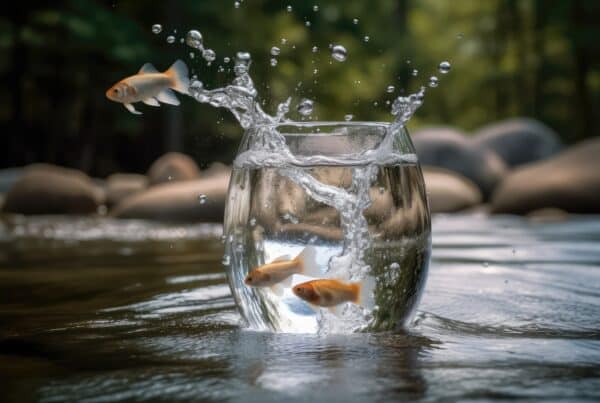In many discussions around what effective leadership requires in these testing times, we repeatedly, and almost tediously, hear the word “resilience.” Yet, what does resilience mean to us? And is it a fair measure of great leadership?
For many of us, our first response to the word “resilience” triggers a sense of having to be tough, meeting all challenges with an energy of force, and not letting anything get to us or sway us. If that’s our starting point, then we’ve already lost the battle as we look at the extraordinary circumstances we have to deal with – health fears, lockdowns, supply shortages, homeschooling, and isolation from family and friends – all while working, leading teams, and keeping organizations thriving (not just surviving) in the face of a whole new business environment!
These extraordinary challenges require next-level thinking. If we persist in believing we must remain solid and immovable objects in the face of a tornado, then we may simply be left feeling broken, overwhelmed, and believing we have failed. And Anne Helen Petersen will be proven right when she said in the Washington Post recently, “The Delta variant arrived at just the right time to break our spirits.”
This is “ground zero” when it comes to leadership – because how we choose to respond and our ability to see that we can choose to respond is totally determined by our mindset. It’s the foundation of becoming the best we can be, the foundation of great leadership. It’s the power of our way of thinking, supported by skills and tools, that make it possible for us to not only get through hard times but to evolve, thrive, and flourish long after them.
While mindset is the foundation to so much of a leader’s success, it’s not something that you can just flip a switch on and change overnight. When we develop an understanding of our current attitudes and why we think and behave the way we do, we can proactively build on that to grow a more creative, agile, innovative mindset. As leaders, it’s important we take the opportunity to regularly stop and check in on how we are showing up to ourselves, to others at work, and home so we can recalibrate from a place of knowledge, understanding, compassion, and strength.
Bob Anderson, Founder of the Leadership Circle, constantly asks the question of himself – How am I getting in my own way? In their best-selling book “Scaling Leadership,” he and CEO Bill Adams write – Leadership – the kind that multiplies capacity and capability in and through others – fundamentally requires that we become more fully human, well-rounded, integrated human beings. At its heart, great leadership is radically human. – that is, showing up more transparent, authentic, vulnerable, empathetic, passionate, and compassionate ways.
We bring that humanity into every meeting room. We continuously evolve our leadership so we can become a leader who gives back to the planet, makes a difference, and enables those in our charge to collectively create results that are innovative, durable, and congruent with what the world needs most. Leadership is the deployment of self into circumstances.
Choosing to respond in different ways and continuing to grow both our mindset and ourselves through reflection, self-care, and change is evocatively represented in the Japanese art form “kintsugi,” which means to repair with precious metals. Today when something is broken, we often discard it. Under the principles of kintsugi, when a ceramic bowl breaks, it is pieced together using gold or silver to bind the broken pieces. Not only is the restored bowl stronger, but it is also more beautiful. Being broken and repaired is part of the bowl’s history, to be celebrated and not something to be hidden.
So, it is also with people. Being confidently vulnerable with that which has helped us grow means we are constantly evolving in how we deal with life. The cracks are not plastered over, but rather we embrace that “which is,” build on it, and create an “upgraded version of ourselves” to move forward stronger and more able to manage the new complexities or changing environment that led to the cracks in the first place.
But here’s where things get really interesting! As we shapeshift through constantly changing times, it’s easy to lose sight of why we are doing what we are doing. And shapeshifting takes energy, attention, and focus. If we deplete ourselves in the process, we will not be leading long and healthy lives, nor will we provide the longevity of service that our teams and organizations may require of us – quite the opposite. So what keeps us on track? What’s the north star that continues to shine through whatever “kintsugi-ed iteration” we emerge with?
In 2004, award-winning journalist and author Dan Buettner teamed up with National Geographic and the world’s best longevity researchers to identify areas around the world where people live measurably longer and better. The result was five “Blue Zones” circled on a world map – where people typically reached age 100 at rates ten times greater than the US statistics. These are Sardinia (Italy), Okinawa (Japan), Loma Linda (California), Nicoya Peninsula (Costa Rica), and Icaria (Greece).
Nick Buettner is the Vice President of Blue Zones. When I caught up with Nick and asked him for his thoughts about mindset and healthy aging, he said that in the Blue Zone pockets around the world, the thing that overwhelming characterized them all was that people not only had a strong sense of purpose but could articulate it clearly and authentically, whether they were 20 or 100.
“This purpose is their reason to get up in the morning and is a crucial element that helps them get through the tough times,” Nick said.
So what is your sense of purpose? What is the north star that guides your decisions and actions and inspires you to get up each day?
In summary, while our world is becoming increasingly complex and unpredictable, it’s also providing us with countless opportunities to reflect on what leadership means and to actively develop the mindset, skills, and tools that support great leadership.
If leadership is about becoming “radically human,” then there’s one thing we can do each day. Ask ourselves, “How am I getting in my own way?”; answer truthfully and be prepared to act. Remember the beauty of the Japanese teacup and the principle of kintsugi – being “repaired” maintains the integrity of the original creation while creating something even more beautiful and enduring.
Kerry Azar
Head of Strategic Partnerships Leadership Circle Asia Pacific Kerry’s extensive background includes working in Australia, Europe, the USA, and Asia. Her commercial leadership roles included Business Development Manager for an internet company during the heady dot.com/dot.crash days. Her last commercial role was as Managing Director, standing up and leading the European subsidiary of an Australian Stock Exchange-listed Aerospace and Defence company. She also has a teaching background working at universities including QUT, RMIT, Monash, and as a visiting Professor at a Bavarian university in 2017. Kerry was a researcher and part of the Author Team for the “The Mind of the Leader – How to Lead Yourself, Your People and Your Organization for Extraordinary Results” published in 2018 by Harvard Business Review Press. Kerry Azar works as our Leadership Circle Head of Strategic Partnerships Asia Pacific. Her role encapsulates working with both certified Leadership Circle practitioners and consulting clients.





